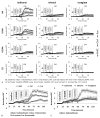Efficacy of preventive interventions for iodinated contrast-induced acute kidney injury evaluated by intrarenal oxygenation as an early marker
- PMID: 24872003
- PMCID: PMC4470575
- DOI: 10.1097/RLI.0000000000000065
Efficacy of preventive interventions for iodinated contrast-induced acute kidney injury evaluated by intrarenal oxygenation as an early marker
Abstract
Objective: The objective of this study was to evaluate the effects of potential renoprotective interventions such as the administration of N-acetylcysteine (NAC; antioxidant) and furosemide (diuretic) on intrarenal oxygenation as evaluated by blood oxygen level-dependent (BOLD) magnetic resonance imaging (MRI) in combination with urinary neutrophil gelatinase-associated lipocalin (NGAL) measurements.
Materials and methods: Rats received nitric oxide synthase inhibitor L-NAME (10 mg/kg) and cyclooxygenase inhibitor indomethacin (10 mg/kg) to induce the risk for developing iodinated contrast-induced acute kidney injury before receiving one of the interventions: NAC, furosemide, or placebo. One of the 3 iodinated contrast agents (iohexol, ioxaglate, or iodixanol) was then administered (1600-mg organic iodine per kilogram body weight). Fifty-four Sprague-Dawley rats were allocated in a random order into 9 groups on the basis of the intervention and the contrast agent received.Blood-oxygen-level-dependent MRI-weighted images were acquired on a Siemens 3.0-T scanner using a multiple gradient recalled echo sequence at baseline, after L-NAME, indomethacin, interventions or placebo, and iodinated contrast agents. Data acquisition and analysis were performed in a blind fashion. R2* (=1/T2*) maps were generated inline on the scanner. A mixed-effects growth curve model with first-order autoregressive variance-covariance was used to analyze the temporal data. Urinary NGAL, a marker of acute kidney injury, was measured at baseline, 2 and 4 hours after the contrast injection.
Results: Compared with the placebo-treated rats, those treated with furosemide showed a significantly lower rate of increase in R2* (P < 0.05) in the renal inner stripe of the outer medulla. The rats treated with NAC showed a lower rate of increase in R2* compared with the controls, but the difference did not reach statistical significance. Urinary NGAL showed little to no increase in R2* after administration of iodixanol in the rats pretreated with furosemide but demonstrated significant increase in the rats pretreated with NAC or placebo (P < 0.05).
Conclusions: This is the first study to evaluate the effects of interventions to mitigate the deleterious effects of contrast media using BOLD MRI. The rate of increase in R2* after administration of iodinated contrast is associated with acute renal injury as evaluated by NGAL. Further studies are warranted to determine the optimum dose of furosemide and NAC for mitigating the ill effects of contrast media. Because NGAL has been shown to be useful in humans to document iodinated contrast-induced acute kidney injury, the method presented in this study using BOLD MRI and NGAL measurements can be translated to humans.
Conflict of interest statement
Conflicts of interest: The authors declare no conflicts of interest.
Figures



Similar articles
-
Evaluation of intrarenal oxygenation in iodinated contrast-induced acute kidney injury-susceptible rats by blood oxygen level-dependent magnetic resonance imaging.Invest Radiol. 2014 Jun;49(6):403-10. doi: 10.1097/RLI.0000000000000031. Invest Radiol. 2014. PMID: 24566288 Free PMC article.
-
Effect of iodinated contrast medium in diabetic rat kidneys as evaluated by blood-oxygenation-level-dependent magnetic resonance imaging and urinary neutrophil gelatinase-associated lipocalin.Invest Radiol. 2015 Jun;50(6):392-6. doi: 10.1097/RLI.0000000000000141. Invest Radiol. 2015. PMID: 25668748 Free PMC article.
-
Intrarenal oxygenation by blood oxygenation level-dependent MRI in contrast nephropathy model: effect of the viscosity and dose.J Magn Reson Imaging. 2012 Nov;36(5):1162-7. doi: 10.1002/jmri.23747. Epub 2012 Jul 23. J Magn Reson Imaging. 2012. PMID: 22826125 Free PMC article. Clinical Trial.
-
Neutrophil gelatinase-associated lipocalin (NGAL): a promising biomarker of contrast-induced nephropathy after computed tomography.Ren Fail. 2014 Jul;36(6):979-86. doi: 10.3109/0886022X.2014.900429. Epub 2014 Mar 27. Ren Fail. 2014. PMID: 24673459 Review.
-
Neutrophil gelatinase-associated lipocalin as a marker of acute renal disease.Curr Opin Hematol. 2011 Jan;18(1):11-8. doi: 10.1097/MOH.0b013e3283411517. Curr Opin Hematol. 2011. PMID: 21102325 Review.
Cited by
-
BOLD magnetic resonance imaging in nephrology.Int J Nephrol Renovasc Dis. 2018 Mar 13;11:103-112. doi: 10.2147/IJNRD.S112299. eCollection 2018. Int J Nephrol Renovasc Dis. 2018. PMID: 29559807 Free PMC article. Review.
-
Understanding and preventing contrast-induced acute kidney injury.Nat Rev Nephrol. 2017 Mar;13(3):169-180. doi: 10.1038/nrneph.2016.196. Epub 2017 Jan 31. Nat Rev Nephrol. 2017. PMID: 28138128 Review.
-
Assessing renal changes after remote ischemic preconditioning (RIPC) of the upper extremity using BOLD imaging at 3T.MAGMA. 2018 Jun;31(3):367-374. doi: 10.1007/s10334-017-0658-4. Epub 2017 Oct 23. MAGMA. 2018. PMID: 29063424
-
The Ameliorative Role of Acacia senegal Gum against the Oxidative Stress and Genotoxicity Induced by the Radiographic Contrast Medium (Ioxitalamate) in Albino Rats.Antioxidants (Basel). 2021 Feb 2;10(2):221. doi: 10.3390/antiox10020221. Antioxidants (Basel). 2021. PMID: 33540787 Free PMC article.
-
Systemic and renal hemodynamic effects of intra-arterial radiocontrast.Intensive Care Med Exp. 2014 Dec;2(1):32. doi: 10.1186/s40635-014-0032-z. Epub 2014 Dec 16. Intensive Care Med Exp. 2014. PMID: 26266929 Free PMC article.
References
-
- Berlyne N, Berlyne GM. Acute renal failure following intravenous pyelography with hypaque. Acta Med Scand. 1962;171:39–41. - PubMed
-
- Lacquaniti A, Buemi F, Lupica R, et al. Can neutrophil gelatinase-associated lipocalin help depict early contrast material-induced nephropathy? Radiology. 2013;267:86–93. - PubMed
-
- Brezis M, Rosen S. Hypoxia of the renal medulla—its implications for disease. N Engl J Med. 1995;332:647–655. - PubMed
MeSH terms
Substances
Grants and funding
LinkOut - more resources
Full Text Sources
Other Literature Sources
Medical
Miscellaneous

